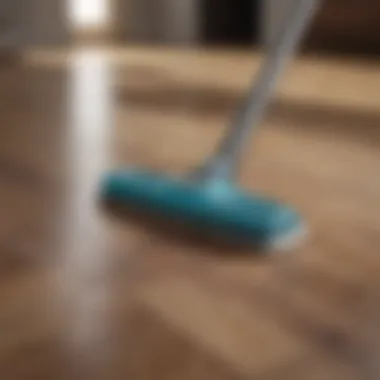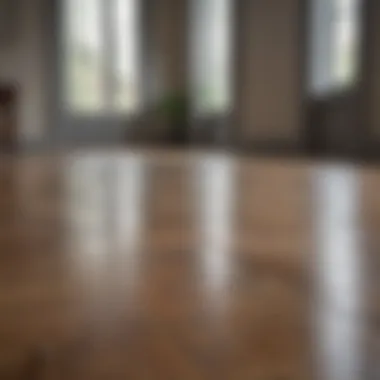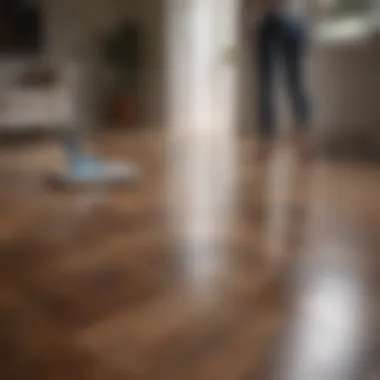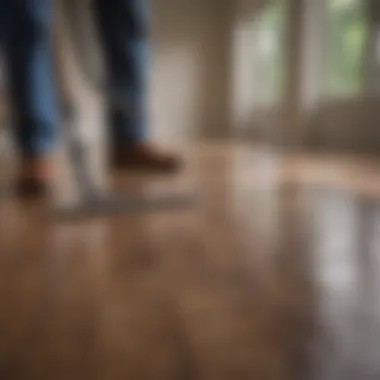A Guide to Cleaning and Maintaining Laminate Floors


Intro
Keeping laminate floors looking their best is not just about the hardwood look; it’s about maintaining an investment that adds both value and aesthetic appeal to your home. People often overlook that careful cleaning techniques can significantly extend the life of laminate flooring while preserving its charm. This guide is here to walk you through the ins and outs of cleaning laminate floors. We’ll journey through effective methods, recommended tools, and preventative care measures.
Cleaning laminate floors can feel like a daunting task, but when approached with the right mindset and tools, it can become less of a chore and more of an essential home ritual. Ensuring your floors shine like new can influence the overall environment of your space, boosting its appeal to guests or even potential buyers.
It's crucial to understand that laminate flooring, while attractive and durable, requires specific care to avoid scratches, warping, or discoloration. In this guide, we’ll also emphasize some common pitfalls that you should steer clear of, giving your floors the tender love and care they deserve.
Let's delve into the next section where we’ll get an overview of some architectural inspirations that can influence both the cleaning and aesthetic upkeep of your laminate flooring.
Understanding Laminate Floors
When it comes to maintaining a home, understanding the flooring material is like knowing the ropes in a climbing expedition. It's critical. Especially laminate floors, which have gained a significant following in the modern household. Thus, comprehending their characteristics, benefits, and the common myths surrounding them sets the stage for effective cleaning and care. In this guide, we dig deeper into what makes laminate flooring a popular choice.
What Are Laminate Floors?
At a glance, laminate floors can appear quite luxurious. They consist of multiple layers, crafted to imitate the appearance of wood, stone, or other materials. The core layer is made from high-density fiberboard, while an image layer—designed to capture the desired aesthetic—is placed atop. Finally, a transparent protective layer prevents scratches and dents. This construction results in a product that is not only visually appealing but also durable under the right care.
Unlike solid wood, laminate isn’t a single piece of material, which explains its affordable price tag. Yet, don’t let that fool you into thinking it lacks quality. Laminate has come a long way in terms of technology and design, often fooling guests into believing they are stepping onto a hardwood surface. One thing to keep in mind, however, is that while laminate is durable, it can be affected by excessive moisture or scratches from rough cleaning practices.
Advantages of Laminate Flooring
Laminate flooring offers a range of benefits that cater to a diverse audience. Here are some noteworthy advantages:
- Cost-Effective: Compared to solid hardwood, laminate flooring is generally more affordable, making it an attractive option for homeowners on a budget.
- Easy Installation: Many laminate flooring products are designed for DIY installation, featuring a click-lock system that allows for straightforward assembly.
- Variety of Designs: With countless styles available, from rustic wood finishes to sleek modern looks, there’s something for everyone.
- Resistant to Fading and Scratching: Modern laminate floors are designed to withstand heavy foot traffic and tend to resist fading more than traditional hardwood.
Now, for anyone who's ever spilled something on a floor, the resilience of laminate against spills is reassuring. When cleaned appropriately, laminate can look just as pristine as other high-end flooring options without the extensive maintenance needed.
Common Misconceptions About Laminate Floors
Every rose has its thorns, and laminate flooring is no exception. There are several misconceptions surrounding this type of flooring that can mislead potential buyers.
- Laminate is the Same as Vinyl: While both laminate and vinyl flooring can mimic other surfaces, they are made from different materials. Laminate consists of fiberboard, whereas vinyl is made from synthetic materials. Each has unique durability and maintenance requirements.
- Laminate Floors Can’t Be Refinished: Unlike solid wood, which can be sanded and refinished multiple times, laminate floors are usually not refinishable. Once they show significant wear or damage, they often need to be replaced.
- All Laminate Floors are Noisy: While issues with noise can arise, they are typically influenced by the underlay used. A good quality underlayment can mitigate sound and make laminate floors just as quiet as many hardwood options.
Understanding these points helps in appreciating laminate flooring for what it truly is—a practical choice for many homeowners. By knowing the ins and outs, the cleaning process can be approached not just carefully, but confidently.
Preparing to Clean Your Laminate Floors
Cleaning laminate floors involves more than just grabbing a mop and a bucket. It’s a systematic process that requires preliminary preparation to ensure the best outcomes. When we talk about preparing to clean, we’re really discussing the mindset and the groundwork necessary to tackle the task efficiently. This involves gathering the right tools and assessing the current condition of the flooring, which can significantly impact your cleaning approach.
This preparation paves the way for a smoother process. By knowing your materials and what kind of dirt you’re dealing with, you’ll know whether you need a light touch or a more rigorous cleaning technique. Moreover, a little forethought saves time and effort, keeping the floors in good shape and enhancing their longevity.
Gathering the Necessary Tools
Equipping yourself with the right tools is fundamental in any cleaning task. Good tools make a difference between a chore and a breeze.
Microfiber Mop
The microfiber mop stands out because of its exceptional ability to trap fine dirt and dust. Unlike traditional mops that merely push dirt around, the microfiber material clings to particles effectively, requiring less water and cleaner. This makes it a preferred choice among many cleaners.
Key Characteristic: Its ability to hold onto dirt without scratching the laminate surface.
A unique feature of the microfiber mop is its reusable cloths, making it not only eco-friendly but also cost-effective over time. You’ll find that the ease of washing these cloths meets both convenience and sustainability. However, remember that while it’s great for day-to-day cleaning, stubborn marks might still need a more focused approach.


Broom and Dustpan
The broom and dustpan might seem basic, but they play a crucial role in your laminate cleaning routine. A soft-bristle broom is gentle enough for maintaining laminate and is adept at pulling up loose debris. This manual approach can be quite effective in removing larger pieces of dirt that could scratch the floor if left unattended.
Key Characteristic: Their portability and simplicity are hard to beat.
One unique aspect is that there are specially designed brooms available that enhance dust pickup, often thanks to materials that create a static charge. They do tend to require more effort than vacuuming, but many enthusiasts find a connection to this old-school method. However, they also miss out on the efficiency and thoroughness a vacuum can provide, especially in corners.
Vacuum Cleaner
Using a vacuum cleaner specifically designed for hard floors can save time and ensure thoroughness. A vacuum removes dirt that mops or brooms may miss, especially the hard-to-reach nooks and crannies. It’s worth investing in models that have adjustable suction power, to avoid any risk of scratching.
Key Characteristic: Precise suction control is essential for preserving laminate integrity.
The best vacuums feature attachments specifically made for hard floors, making them multifaceted tools in your cleaning arsenal. They tend to increase the time it takes to clean because they often require more preparation compared to mopping, yet the results can be significantly cleaner floors.
Cleaning Solution
Choosing the right cleaning solution is paramount. Not all cleaners are suitable for laminate; using the wrong one can lead to dullness or damage. Ideally, you want pH balanced solutions that won’t leave behind a residue.
Key Characteristic: Compatibility with laminate flooring to avoid unwanted outcomes.
You’ll also find formulations specific for laminate that offer additional benefits such as shine or protection. However, while premium solutions may promise remarkable features, many are quite straightforward. Be careful, though, as excessive reliance on cleaning solutions can lead to build-up over time.
Assessing the Condition of Your Floors
Before diving into cleaning, it’s crucial to take a moment and look at the overall state of your floors. Are there any deep scratches? How often have they been cleaned? Recognizing the condition helps set the stage for what cleaning methods are suitable.
- Minor Scratches: Might just need a soft touch and routine cleaning.
- Moderate Damage: Could warrant more intensive methods such as specific cleaning solutions or techniques.
- Severe Low Quality: Again might require professional assistance.
In short, taking a close look can make a world of difference in how you approach the cleaning task. Knowing the laminated flooring condition influences every decision from tools to techniques, ensuring that your cleaning mission fosters a long-life relationship with your floors.
Step-by-Step Cleaning Process
Cleaning laminate floors can seem like a daunting task, but with a structured approach, it becomes manageable and even quite rewarding. This step-by-step cleaning process is not just about achieving a sparkling finish; it’s also about ensuring the longevity of your floors. A consistent cleaning regimen helps maintain the aesthetic appeal while preventing damage that can lead to costly repairs down the line. Here’s what you need to know.
Dry Dusting and Sweeping
Removing Loose Dirt and Debris
The first step in keeping your laminate floors looking pristine is tackling loose dirt and debris. This phase is crucial because any grit left on the surface can act like sandpaper, gradually scratching the laminate’s protective layer. Using a broom or vacuum cleaner can effectively lift this grime away without needing moisture, which is essential for laminate.
Key characteristics of removing loose dirt include ease and efficiency. It’s a simple, quick fix that can be done daily, ensuring the floor remains clean. Neglecting this step can lead to bigger problems such as scratches or dull appearances, making it a beneficial choice for maintaining the overall look of your floors. However, using a broom that has stiff bristles can sometimes push dirt around instead of collecting it, which is a disadvantage to consider.
Best Practices for Dry Dusting
When discussing best practices for dry dusting, one should consider the tools that yield the best results. A microfiber mop, for instance, is an exceptional option due to its fine fibers that attract dust effectively. It’s lightweight and requires no additional products to get started.
The unique feature of this approach is that it prepares the surface before damp cleaning, minimizing the chances of scratching. It’s beneficial for maintaining hygiene as well; dust particles can harbor allergens and microbes. Nevertheless, a word of caution: always ensure to use a clean mop head to avoid redistributing dirt rather than removing it.
Wet Cleaning Techniques
Choosing the Right Cleaning Solution
Venturing into wet cleaning, one must focus on selecting the right solution for the task. Not every product is suitable for laminate floors due to the specific materials used in their construction. Products that are too harsh can strip the protective coating, which opens up a world of potential damage.


A mild, pH-balanced cleaner is considered a smart option for upkeep—it not only cleans effectively but also protects the integrity of your flooring. This unique feature provides an advantage that many users may overlook—preventing more substantial wear and tear in the long run. But remember, overusing any cleaner can cause build-up, making the solution a double-edged sword for inexperienced users.
Applying the Cleaner Efficiently
Now, when it comes to applying the cleaner efficiently, the focus shifts towards technique. A good formula won’t work wonders if misapplied; the key is a damp, not soaking-wet, mop. This ensures that you’re not introducing excess moisture that could warp or bubble the laminate.
Advantages of this method include removing stubborn stains while preserving the laminate's finish. A disadvantage, however, can be the occasional streaking if too much solution is used. You may want to always follow the manufacturer's guidelines here to keep things in check.
Spot Cleaning Stains and Spills
Identifying Different Types of Stains
When a spill happens, knowing how to identify different types of stains can save your floors. Each type, whether it’s a juice mark or a grease spot, may require a specific approach.
Understanding this characteristic of stains is advantageous because it allows for targeted cleaning methods that effectively tackle the issue without damaging the laminate. Unique in this context, some stains can freeze on the surface, making them easier to lift if caught quickly. Conversely, letting them sit can set a stain, leaving you with a bigger mess to deal with later.
Best Spot Cleaning Methods
Lastly, let’s talk about best spot cleaning methods. The most recommended approach for those unfortunate spills is to blot, not rub. Rubbing can lead to spreading the substance or even further embedding it into the floor’s finish. Instead, often, a simple solution of mild soap and water or a specialized stain remover can handle it.
The combination of rapid response and methodical cleaning has been highlighted repeatedly as a favoured strategy. However, be wary of overusing any chemical solution, as it may disrupt the sheen or protective coating over time. Keeping this balance is critical for long-term maintenance of your laminate floors.
"Cleaning laminate floors requires a two-pronged approach: tackle loose dirt first, and then methodically address spills."
In summary, a step-by-step cleaning process not only maintains the beautiful look of your laminate floors but also extends their life considerably. Always prioritize gentle methods and the right tools to keep your investments in top shape.
Preventing Damage While Cleaning
Maintaining the pristine look of your laminate floors requires a delicate balance. While regular cleaning is essential, preventing damage during the cleaning process is equally vital. The wrong approach can lead to scratches, warps, and a host of other issues that compromise the aesthetic and functional integrity of your flooring. This section dives into key strategies on how you can clean effectively without introducing any harm.
Avoiding Excess Water
Water is a necessary agent in any cleaning regimen, but too much of it can spell disaster for laminate floors. These floors are constructed with a core that can swell if exposed to excess moisture. Consequently, this swelling can warp the laminate planks, leading to an uneven surface.
To avoid this problem, consider the following:
- Use a Damp Mop: Instead of soaking your mop, just dampen it. Aim for a barely wet mop that can lift dirt without saturating the surface.
- Immediate Clean-Up: If spills occur, it’s essential to wipe them up quickly. Waiting can allow moisture to seep into seams and under the flooring.
- Flooring Condition Check: Assess the flooring condition regularly. An older floor may need extra care, so observe for any signs of wear or damage which may warrant a gentler touch.
"An ounce of prevention is worth a pound of cure."
It’s always better to take precautions than to face costly repairs later.
Choosing the Right Tools and Products
The tools and cleaning products you choose can significantly impact the care and longevity of your laminate floors. If you reach for harsh or unsuitable solutions, you may inadvertently cause scratches or dulling in the finish.
Here are some tips for selecting the right accessories:
- Opt for Microfiber Mops: They are soft and effective for capturing dust and dirt without scratching the laminate surface.
- Avoid Steam Cleaners: These can generate excess moisture, which is hazardous for laminate. Stick to traditional mopping methods instead.
- Check Labels: Always read product labels before use. Ensure any cleaner is safe for laminate flooring to prevent damage.
- DIY Solutions: Sometimes, making your own cleaning solution can be effective. A mixture of vinegar and water is often touted as a gentle, effective cleaner.
By understanding the specific requirements of your laminate flooring and consistently employing the right methods and products, you can maintain your floors effectively while preventing potential damage.
Common Mistakes to Avoid
Taking care of laminate floors isn’t just about getting them cleaned; it’s about doing it right. Committing a few common mistakes can lead to unnecessary damage and may even shorten the lifespan of your beloved floors. By avoiding these pitfalls, you’re not only preserving the beauty of your laminate but also ensuring they will serve you well into the future. Here are some of the typical slip-ups that can make a world of difference in your cleaning routines.


Using Harsh Chemicals
When it comes to laminate floors, some people might think that using industrial-strength cleaning solutions is the best way to get rid of dirt and grime. However, this couldn’t be further from the truth. Harsh chemicals can erode the protective finish on your laminate, leading to scratches, dullness, and eventually, peeling. It's like using a sledgehammer to drive in a nail—you may get the job done, but at what cost?
Instead, opt for gentler cleaning solutions formulated specifically for laminate surfaces. You'd want products that can handle tough stains without causing harm. A simple mix of warm water and vinegar or a few drops of dish soap can work wonders. Not only do these cleaners effectively cut through grease, they also protect your floor’s finish.
Neglecting Regular Maintenance
Another critical oversight people often make is neglecting a regular maintenance routine. You wouldn’t ignore the oil change in your car, right? The same logic applies to your floors. Regular cleaning and maintenance can serve as the first line of defense against dirt build-up and wear.
Aim to dust or sweep your floors daily, and schedule a more thorough clean on a weekly or bi-weekly basis. Leaving dirt and sand to settle can lead to scratches, dullness, and other unwanted imperfections over time.
Here are a few maintenance tips to keep your laminate floors in tip-top shape:
- Use soft-bristle brooms to avoid scratching the surface.
- Empty the vacuum canister often to ensure maximum efficiency.
- Avoid dragging furniture across the floor; instead, lift when moving.
- Periodically check for scratches and address them early to prevent them from worsening.
"An ounce of prevention is worth a pound of cure."
By staying consistent and mindful in your cleaning practices, you will keep your laminate floors looking brand new for years to come.
In summary, you don't usually need fancy products or processes to clean laminate floors correctly. Just a little know-how and consistency can go a long way. Each effort you make towards understanding and avoiding these mistakes ensures that your floors remain a point of pride, not a source of stress.
Routine Maintenance Tips
Maintaining your laminate floors is not just a chore; it’s an investment in the longevity and aesthetic appeal of your home. Regular upkeep prevents wear and tear, keeps them looking fresh, and ensures you maximize their lifespan. Unlike other floor types that may require extensive restoration, laminate benefits greatly from consistent cleaning and protection.
Creating a Cleaning Schedule
Setting up a regular cleaning schedule is paramount. Without a rhythm to your cleaning, dirt and grime can accumulate, potentially leading to scratches or dull patches. A simple plan is more manageable than it sounds. Here’s how you can structure it effectively:
- Daily Tasks: Sweeping or dusting to pick up small debris and avoid buildup.
- Weekly Duties: A thorough wet mop using laminate-appropriate cleaners to fend off stubborn marks.
- Monthly Maintenance: Check the condition of the floor, looking for signs of wear, and address any issues promptly. Re-evaluate your cleaning products every month to ensure they remain suitable for laminate surfaces.
By keeping a consistent routine, your floors will thank you in the long run.
Talking About Protective Measures
Using Rugs and Mats
Rugs and mats serve a dual purpose in maintaining laminate floors. They not only add to the aesthetic charm of a living area but also act as a barrier against dirt and damage. Their ability to catch dust from shoes ensures that you’re not dealing with persistent scratches from the get-go.
- Key Characteristic: They are soft and absorbent, helping to reduce the impact on flooring from tools and furniture.
- Why It's Beneficial: Their presence simplifies cleaning, as they can be washed separately, while also adding style and warmth to the space.
- Advantages: A well-placed mat at the entryway can extend the life of your laminate floor by keeping dirt at bay.
- Disadvantages: However, be cautious with rubber-backed mats since they can trap moisture, leading to potential damage.
Furniture Placement Strategies
How you arrange your furniture can significantly impact the health of your laminate floor. Consider weight distribution; heavy furniture should ideally be kept in less-trafficked areas. This not only prevents potential indentations but also promotes easier cleaning and floor maintenance.
- Key Characteristic: Proper placement avoids dragging or shifting furniture, which risks scratching the floor.
- Why It's Beneficial: It contributes to an organized aesthetic and reduces wear in high-traffic zones.
- Unique Feature: Using leg protectors under furniture legs can dramatically minimize pressure points. However, it's important to ensure that whatever protector you use doesn’t leave marks itself.
By integrating these protective measures into your routine, you build a safeguard around your laminate flooring that can yield significant benefits. After all, a little bit of foresight can save you a lot of grief down the line!
The End
In the grand tapestry of maintaining a home, cleaning laminate floors may seem like a small thread. However, when you look closely, it plays a significant role in preserving the beauty and integrity of your living space. This article has highlighted various essential techniques and considerations that ensure laminate floors remain a shining asset of your home.
Understanding the importance of effective cleaning methods not only protects your floors but also extends their lifespan. Laminate flooring, while designed to withstand wear and tear, benefits significantly from regular upkeep. Regular cleaning habits can mitigate potential damage, such as scratches or stains, which can detract from their visual appeal and functionality.
Moreover, being aware of the common pitfalls—like using harsh chemicals or allowing excess water to linger—provides additional layers of protection. As noted throughout this discussion, selecting the right tools and cleaning solutions is paramount. Products specifically formulated for laminate floors can make a world of difference in maintaining their finish and preventing damage.
“Proper care is not just about keeping things clean; it's about preserving value and aesthetics.”
Routine maintenance tips, such as creating a cleaning schedule and using protective measures like rugs and mats, serve as proactive approaches to floor care. By integrating such practices into daily life, you’re not just cleaning your floors—you’re investing in your home’s charm and reliability.







